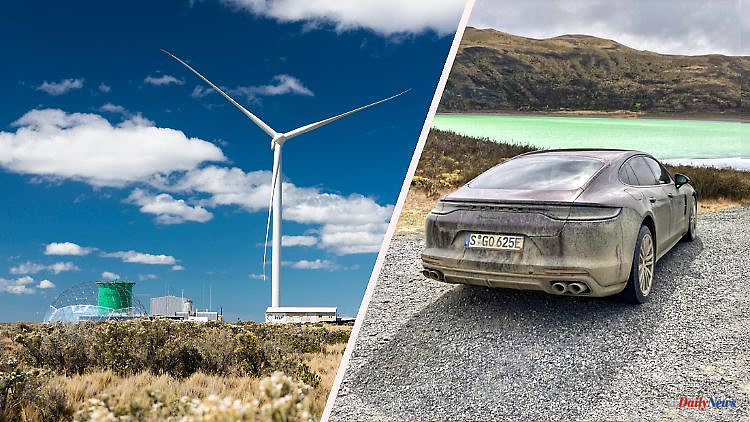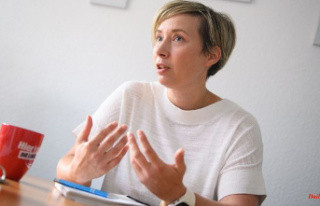Porsche plans to drastically increase the production of e-fuels within a few years. The topic is controversial, but is considered an important part of CO2-neutral mobility. ntv.de was on the road with the sporty Panamera limousine, whose fuel was actually produced in a climate-neutral manner.
It's time to do away with prejudices. I have to smile when Hannover's Lord Mayor Belit Onay talks to Markus Lanz on the talk show that handling e-fuels is far too complicated. He asks who should actually take on the conversion of the many combustion engines. conversion?
The Panamera fleet, which Porsche has not unprominently parked in front of its southern Chilean e-fuel plant, actually consists of conventional combustion vehicles, mind you, not converted. Porsche has taken a few hybrid variants with it, including limousines and Sport Turismo and even a top model (Turbo S), which is powered solely by the coveted eight-cylinder petrol engine and therefore does not require any electrical support.
Of course I'm curious, so I asked development engineer Karl Dums, who is responsible for synthetic fuels. Whether there are any special conditions to be able to fill up with this new type of fuel at all. He waves it off. The goal must even be, he emphasizes, to be able to mix synthetic and fossil fuels in any ratio. It is clear that every existing combustion engine should be able to be fueled with it in order to achieve maximum flexibility when saving CO2.
Understood and taken a seat in the Panamera Hybrid. Ah, just a moment: The tank is almost empty, so the friendly man in protective clothing from the e-fuel facility asks us to the pump. The elegant limousine is refueled within five minutes - with climate-neutral premium petrol, mind you. Kind of crazy. So don't stand at the charging station and wait half an hour. Just for the back of your head.
Before we go straight into the discussion of what exactly speaks for and against e-fuels, why some think the matter is dead before it even started and for some people exactly the opposite applies, the comfortable part will be dealt with first.
Cozy because the heated seats in the Panamera are so beautifully ergonomic and cuddly. And because the 462 hp high-grader defies the strong wind here in Patagonia, some of which is only six degrees Celsius cold (the wind will play a role later) and its firm, but not too firm chassis offers just the right amount of damping for the winding, but sometimes very beaten country roads of the region. You have to let it melt in your mouth. Combustion engines are used here, and in fact without CO2 emissions. Because precisely the CO2 that escapes from the exhaust pipe is required for production. A closed circuit.
The topic raises dust, quite a lot of dust in fact. Nothing less than the only apparent social consensus (in any case, there is none within the EU) - depending on the filter bubble you are in at the moment - that electromobility is the only way to make CO2-free possible is suddenly on the brink. The Commission and the European Parliament had already given the green light for phasing out combustion engines, and now the Council of Ministers should recently make a legally binding decision that combustion engines will no longer be permitted in Europe from 2035. And now? voting postponed. Indefinitely. Of course, it is by no means the case that the advocates of the combustion engine want to be accused of being climate sinners. No, it is of course about fuels, which should rather be produced in a climate-neutral manner. Why shouldn't the combustion engine be allowed to live on if it doesn't cause any CO2 emissions?
Opponents of the venture point out that the energy consumption is far too high. There's something to it. Porsche's e-fuel expert Dums doesn't deny that at all. He explains that it takes 20 kWh to synthesize a single liter of gasoline, which incidentally contains 9 kWh of energy. In addition, three liters of water are required for every liter of petrol. To clarify: With 20 kWh of electricity in the battery, some electric cars can drive 150 kilometers – while with one liter of fuel in the tank of an economical car you can perhaps cover just over 20 kilometers.
Many intermediate steps in the production of synthetic fuel consume energy. For example, the extraction of CO2 for the production of liquid fuels. Then, if necessary, water must also be desalinated - this requires electricity. And last but not least, the hydrogen produced as an intermediate stage during electrolysis has to be processed further at a loss. E-fuels are therefore truly a resource-intensive matter. One might think that electricity that goes directly from the wind turbine or solar power plant to the battery of an electrically powered vehicle is certainly the smarter strategy for CO2-free mobility.
But it's not that easy. Experts criticize that the discussion is always only partially conducted. That means: In the debate, one often only looks at individual parts of the entire process and ignores those that are possibly unfavorable for the respective personal view and opinion. After all, the perspective from the source to the wheel (i.e. the driven wheel of the car) must always be taken into account, engineers preach. After all, the manufacture of a rechargeable battery also requires a great deal of energy and therefore causes CO2 emissions (CO2 rucksacks for electrically powered new cars). This fact should also be taken into account. And other environmentally harmful effects such as the mining of rare earths in nature reserves are not even included in the energy balance analysis.
So that there are no misunderstandings: Porsche is by no means in favor of an about-face in electromobility. The Zuffenhausen-based company will be launching many electrically powered models over the next few years. By 2030, 80 percent of the Porsche range should have a battery-electric drive. And in general - the majority of new cars will be electric, there is no doubt about that. But driving an entire nation to electric cars with a crowbar within a short time? Will not work. Seen in this way, ramping up the production of synthetic fuels could help to eliminate traffic-related CO2 emissions more quickly and, above all, more effectively.
Arriving at the stage destination of the e-fuel tour, I have trouble opening the car door. Strong wind pushes against them with force. This is also the reason why Porsche wants to produce the e-fuels on the southern tip of Chile. The wind blows quite strongly here 365 days a year - ideal conditions for a decent yield. Together with the Chilean division of the fuel specialist HIF Global, the car manufacturer has set up a pilot plant whose landmark is a wind turbine with an output of 3.4 megawatts that can be seen from afar. That is enough to produce 130,000 liters of fuel per year, which Porsche uses for its Mobil Super 1 Cup racing series. The fuel will later be made available to the Porsche Experience Centers.
But the fuel capacities are to be massively increased in the coming years. Over the next few years, HIF will equip its Haru-Oni test facility near Punta Arenas in southern Chile with 60 wind turbines. Production is to be increased to 55 million liters per year by 2026. And as early as 2028, 550 million liters of the CO2-free fuel are to be produced - every year. This could then be transported directly by ship to Europe and around the world - ideally also using synthetically produced fuel. HIF even wants to create capacities of up to 8.7 billion liters per year by 2030. And once again: The CO2-neutral fuel corresponds exactly to the fossil variant, so it is suitable for every existing vehicle, from any new car to a historic vehicle.
There is no question that a lot of energy goes into the production of synthetic fuels. However, pure fuel efficiency is not always the decisive criterion. Rather, it must be the mixture of efficiency and practical handling. Take hydrogen, for example: it represents a preliminary stage on the way to e-fuel. So why not stop after the electrolysis and use the hydrogen right away? Because the loss of efficiency would then take place elsewhere. The hydrogen, which is volatile at room temperature, either has to be cooled in an energy-intensive manner or transported under pressure. Likewise, its storage is much more complicated and it cannot simply be digested by petrol engines.
There is a great thirst for energy in the world that has to be satisfied, which in the interests of climate protection must come from renewable sources in the future. Above all, it is about huge amounts of electricity for the production of aluminum and steel. The transport sector consumes liquid fuels in large quantities - not just passenger cars, but also airplanes, trucks and ships. In the future, regenerative energies will be generated decentrally, where the wind is always blowing and the sun is shining most of the time. So Chile was chosen with care.
Renewable energy could also be generated in other locations in the future, including Australia, the United States and certainly Africa - wind and sun are abundant on a global scale. Incidentally, also for the electricity that will end up in the batteries of battery electric vehicles. Electromobility is efficient, correct and important. It will come, especially in the Western world. A strict ban on combustion engines would be a pity, instead it is wise to remain open to technology. And this is precisely where e-fuels will make a major contribution. After Porsche and its partners, other car manufacturers and energy companies could also follow this example.












